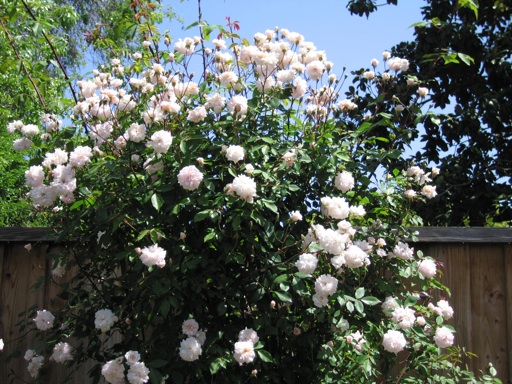
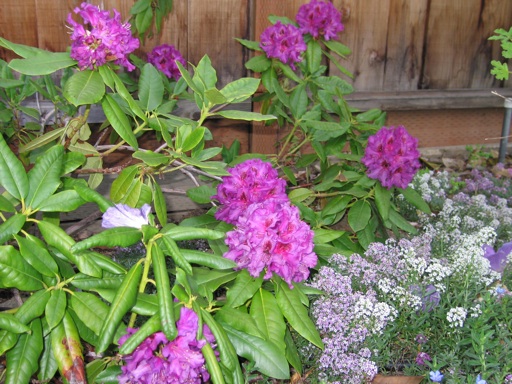

These are more pictures of flowers that are blooming in our garden this spring. The first picture is of a Cecil Brunner climbing rose. Each spring, they are filled with hundreds of cute miniature flowers for a few weeks. But they only bloom once a year. The rest of the year they grow profusely. A bit too profusely in my opinion. I stopped watering them two years ago to try to stunt their growth. But it didn’t work. They still grow dozens of new thorny vines every few months during the growing season. Pruning the new growth has only slowed them down a little. I planted them next to the fence, so they might be getting water from the neighbor’s yard. I am probably going to cut them back severely in a few weeks.
The second picture is a purple rhododendron. I have had this bush about 6 years, and it has bloomed reliably every year. I really love of the color of its flowers.
Rhododendrons like shade in warm climates, acidic soil, and lots of water. Ours is planted in partial shade, although our soil is not particularly acidic. I give it azalea/rhododendron fertilizer once a year in the spring and that has be enough to get it to flower.
The last picture is group of lavender bearded irises. These irises were here when I moved into the house. I almost never water or fertilize them, and they have produced very few blooms. This year they have more flowers than they have ever had. In our climate, we get very little rain from May through October. Bearded irises are supposed to be drought tolerant. I am not sure if they don’t bloom much because they are not getting enough water or fertilizer or both.
May 03 2009 | Flowers and Irises and Rhododendron and Roses | Comments Off on More spring flowers
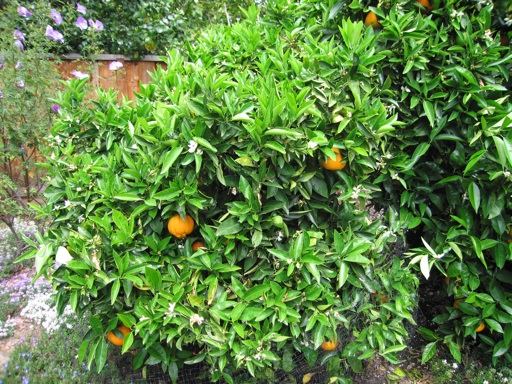
We are lucky enough to live in a house that has an established navel orange bush (see picture). It was planted by one of the previous owners. This bush must be over 20 years old given the girth of its trunk.
Our navel orange bush produces the best tasting oranges I have ever eaten. The flesh of the oranges is soft and tender, unlike the tough fleshed oranges I typically buy in the supermarket. And the flavor is superb. They are juicy, with a nice sweet-tart orange flavor. Although I cannot be sure what type of navel it is, I believe it is a Washington navel given the high quality of the fruit. Washington (Bahia) navel is generally considered to be the best tasting orange.
Although navel oranges are known for ripening in the winter, our navel oranges are ripe now, in April and May. Our climate is probably too cool to stimulate winter ripening, but it appears to be warm enough to generate some very good fruit. Our summer highs average in the high 70s to low 80s, and our winter highs average in the 50s.
The first two years I lived in this house, the leaves of this bush would turn yellow each spring. Then, I learned that yellowing leaves is typically a sign of a lack of nitrogen. Oranges need lots of nitrogen, particularly in the spring when they are growing and blooming. For the past several years, I have been fertilizing our two oranges (navel and valencia) once a month from February through July with a general purpose fertilizer, 16-16-16. The first of these three numbers indicates the percentage of nitrogen in the fertilizer.
I give each bush 3-4 cups in each application, because both of them are quite mature at this point. The result has been more blooms, more oranges, and beautiful dark green leaves throughout the spring and summer months.
Some of our neighbors have large orange trees. They never seem to fertilize them and yet they always look beautiful! I am not sure how they get away with neglecting these trees. Although, our bushes often have more oranges even though they are smaller. 😉
May 03 2009 | Oranges | Comments Off on Navel Orange Bush
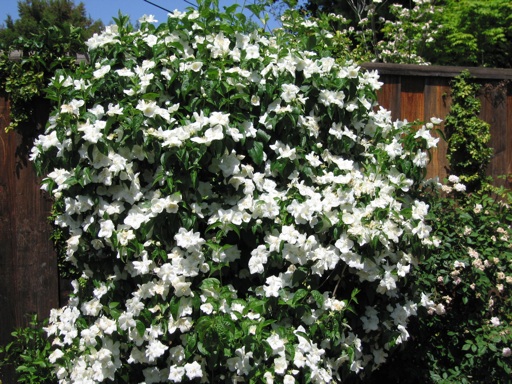
Our deciduous philadelphus (mock orange) bush is full of white flowers right now. The previous owner of the house planted this bush. Because it doesn’t have a tag, I am not sure what kind of philadelphus it is. I didn’t even know it was a philadelphus until I encountered a very similar looking plant at a local nursery.
For the past seven years, it has more than doubled in size with very little care or watering. This year it has more flowers than it has ever had. For several years, it only produced a few flowers each spring. Ever since I removed an old tree that was shading it, this plant has really taken off and grown significantly.
April 26 2009 | Philadelphus | Comments Off on Philadelphus Flowering
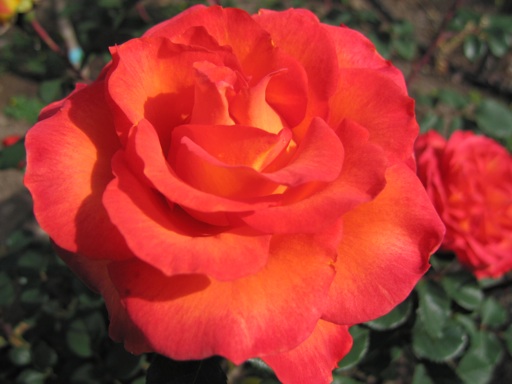
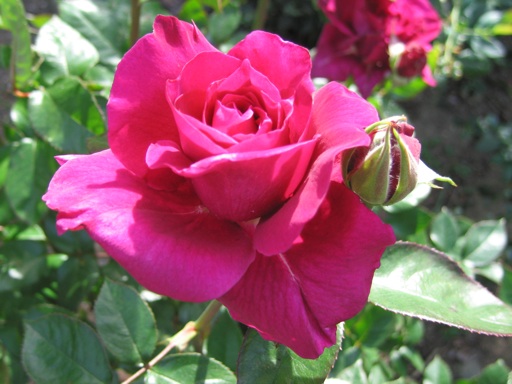
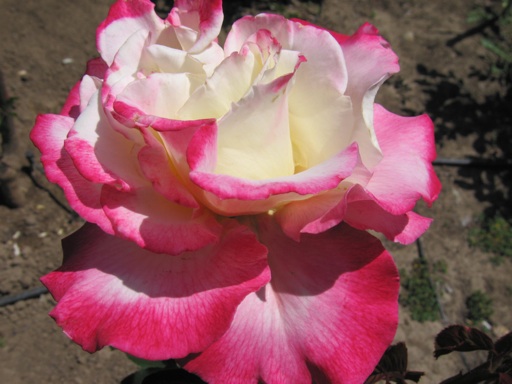
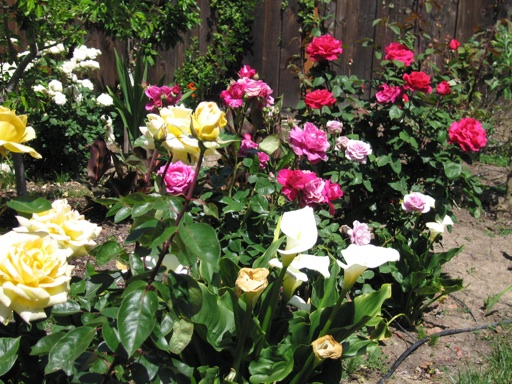
Our backyard roses are at the peak of their first bloom of the 2009 season. The first bloom of the season is usually the most spectacular, because it is the only time of year when all of our roses have flowers at the same time. We have planted red, pink, white, orange, purple, lavender, and yellow roses around the edge of the backyard lawn. The orange rose in the first picture is a ginger snap, the purple rose in the second picture is an intrigue, and the rose in the third picture is a double delight, which has a nice fragrance. All three are hybrid tea roses.
After our roses finish their first bloom in about 2 weeks, I will apply a slow release all-purpose fertilizer to them to stimulate them to bloom again in the summertime. I have noticed that when I haven’t fertilized our roses after the first bloom in the past, they don’t get as many flowers in the following months. When I have fertilized them, they generated second and third sets of blooms that were as amazing as the first bloom. Last year, I gave our roses 2 or 3 applications of fertilizer, in the spring and summer, and our roses bloomed off and on until early November.
April 26 2009 | Roses | Comments Off on First Rose Bloom of the Season
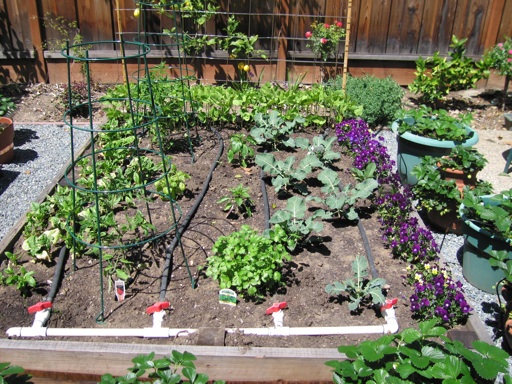
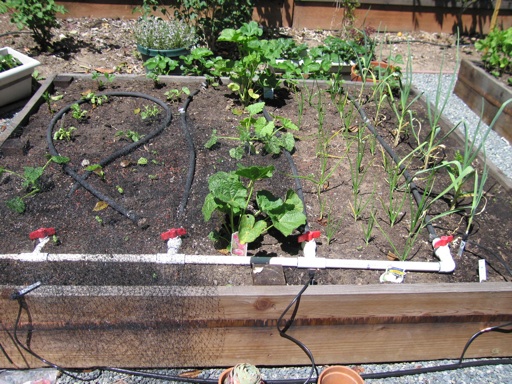
For a long time, I have wanted to grow a vegetable garden like the one my family had when I was growing up. For six years after I moved into my current house, I assumed that I did not have enough time to plant and tend to a vegetable garden. Last year, I realized that I may not have any more free time to tend to a vegetable garden until I retire. I didn’t want to wait that long (at least 25 years away), so I decided to try and make the time.
I wanted raised beds instead of a ground level garden to make it easier to amend the soil and keep the snails away. Rather than spend the time building it myself, I decided to pay the money to have a gardener dig up our side yard lawn, build two raised beds, and put in an automatic watering system.
Once those tasks were completed, it turns out that the vegetable garden did not require a substantial amount of my time. It takes a few hours to visit a nursery, buy the seeds and the transplants, and then plant them. After that, the automatic watering system takes care of the watering. I just need to fertilize and do a bit of weeding once every few weeks. Fertilizing and weeding doesn’t take me much time, because our raised beds are small, one is 6′ x 7′ and the other is 6′ x 8′. Harvesting the produce is the only additional task that needs to be done, and harvesting produce from my yard takes much less time than a trip to the grocery store.
I was telling all of this to one of my neighbors just yesterday. I think I may have convinced her to put in a vegetable garden in her yard.
Over the past several weeks, I have been planting this year’s vegetable garden in our two raised beds. I started this year’s plantings with broccoli in late February. In March, I planted pole bean seeds, cantaloupe and honey dew seeds, carrot seeds, tomato transplants, a zucchini transplant, a basil transplant, onion transplants, and cilantro transplants. So far in April, I have added bell peppers, an eggplant, summer squash transplants, and day neutral strawberry transplants. I also planted violas and hollyhocks to add a bit more visual appeal to the garden. In addition, I planted spinach seeds and garlic transplants last fall that are still growing.
I collected the pole bean seeds from dried up bean pods on last year’s bean plants. All of these bean seeds sprouted quickly, and they are already several inches high, as can be seen in the back of the first picture. I built a simple support for them that is made of two thin wooden posts, and a sturdy metal wire frame that is hanging on hooks I screwed into the wooden posts.
Most of the cantaloupe and honey dew seeds sprouted, but birds ate most of them soon after. Even though I covered them in netting, the birds picked at them through the netting. I know it was birds, because I found feathers near the picked-at seedlings. Frustrated with that experience, I replaced them with cantaloupe transplants I bought from a local nursery. The birds have not touched these yet, probably because they are already large enough to be unappealing.
I planted two sets of the carrot seeds, once in early March and a second one in early April. Many of the carrot seeds I planted in early March didn’t spout. The carrot seeds I planted a few weeks ago are just starting to emerge. This year, I planted white and purple carrots in addition to the yellow and red carrots I planted last year. The yellow carrots did especially well last year. It’s so fun to see such tiny seeds turn into large colorful carrots in just a few months!
April 18 2009 | Vegetables | Comments Off on Vegetable Garden Planted
« Prev - Next »










